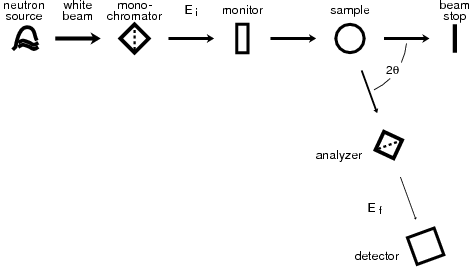
Inelastic neutron scattering
Encyclopedia
Inelastic neutron scattering is an experimental technique commonly used in condensed matter research
to study atomic and molecular motion as well as magnetic and crystal field excitations.
It distinguishes itself from other neutron scattering
techniques by resolving the change in kinetic energy that occurs when the collision between neutrons and the sample is an inelastic
one. Results are generally communicated as the dynamic structure factor
(also called inelastic scattering law) S(q,ω), sometimes also as the dynamic susceptibility χ(q,ω) where the scattering vector q is the difference between incoming and outgoing wave vector
, and is the energy change experienced by the sample (negative that of the scattered neutron). When results are plotted as function of ω, they can often be interpreted in the same way as spectra obtained by conventional spectroscopic
is the energy change experienced by the sample (negative that of the scattered neutron). When results are plotted as function of ω, they can often be interpreted in the same way as spectra obtained by conventional spectroscopic
techniques; insofar as inelastic neutron scattering can be seen as a special spectroscopy.
 Inelastic scattering experiments normally require a monochromatization of the incident or outgoing beam and an energy analysis of the scattered neutrons. This can be done either through time-of-flight techniques (neutron time-of-flight scattering
Inelastic scattering experiments normally require a monochromatization of the incident or outgoing beam and an energy analysis of the scattered neutrons. This can be done either through time-of-flight techniques (neutron time-of-flight scattering
) or through Bragg reflection from single crystals (neutron triple-axis spectroscopy, neutron backscattering
). Monochromatization is not needed in echo techniques (neutron spin echo
, neutron resonance spin echo), which use the quantum mechanical phase of the neutrons in addition to their amplitudes.
Condensed matter physics
Condensed matter physics deals with the physical properties of condensed phases of matter. These properties appear when a number of atoms at the supramolecular and macromolecular scale interact strongly and adhere to each other or are otherwise highly concentrated in a system. The most familiar...
to study atomic and molecular motion as well as magnetic and crystal field excitations.
It distinguishes itself from other neutron scattering
Neutron scattering
Neutron scattering,the scattering of free neutrons by matter,is a physical processand an experimental technique using this processfor the investigation of materials.Neutron scattering as a physical process is of primordial importance...
techniques by resolving the change in kinetic energy that occurs when the collision between neutrons and the sample is an inelastic
Inelastic scattering
In particle physics and chemistry, inelastic scattering is a fundamental scattering process in which the kinetic energy of an incident particle is not conserved . In an inelastic scattering process, some of the energy of the incident particle is lost or gained...
one. Results are generally communicated as the dynamic structure factor
Dynamic structure factor
In condensed matter physics, the dynamic structure factor is a mathematical function that contains information about inter-particle correlations and their time evolution...
(also called inelastic scattering law) S(q,ω), sometimes also as the dynamic susceptibility χ(q,ω) where the scattering vector q is the difference between incoming and outgoing wave vector
Wave vector
In physics, a wave vector is a vector which helps describe a wave. Like any vector, it has a magnitude and direction, both of which are important: Its magnitude is either the wavenumber or angular wavenumber of the wave , and its direction is ordinarily the direction of wave propagation In...
, and
 is the energy change experienced by the sample (negative that of the scattered neutron). When results are plotted as function of ω, they can often be interpreted in the same way as spectra obtained by conventional spectroscopic
is the energy change experienced by the sample (negative that of the scattered neutron). When results are plotted as function of ω, they can often be interpreted in the same way as spectra obtained by conventional spectroscopicSpectroscopy
Spectroscopy is the study of the interaction between matter and radiated energy. Historically, spectroscopy originated through the study of visible light dispersed according to its wavelength, e.g., by a prism. Later the concept was expanded greatly to comprise any interaction with radiative...
techniques; insofar as inelastic neutron scattering can be seen as a special spectroscopy.

Neutron time-of-flight scattering
In Neutron time-of-flight scattering, a form of inelastic neutron scattering, the initial position and velocity of a pulse of neutrons is fixed, and their final position and the time after the pulse that the neutrons are detected are measured...
) or through Bragg reflection from single crystals (neutron triple-axis spectroscopy, neutron backscattering
Neutron backscattering
Neutron backscattering is one of several inelastic neutron scattering techniques. Backscattering from monochromator and analyzer crystals is used to achieve an energy resolution in the order of μeV...
). Monochromatization is not needed in echo techniques (neutron spin echo
Neutron spin echo
Neutron spin echo spectroscopy is an inelastic neutron scattering technique invented by Ferenc Mezei in the 1970's, and developed in collaboration with John Hayter.In recognition of his work and in other areas, Mezei was awarded the first in 1999....
, neutron resonance spin echo), which use the quantum mechanical phase of the neutrons in addition to their amplitudes.
Further Information
Literature:- G L Squires Introduction to the Theory of Thermal Neutron Scattering Dover 1997 (reprint?)

